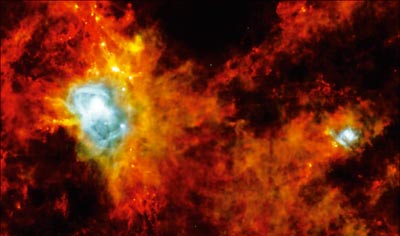
Image credit: ESA/SPIRE & PACS/P André.
The first scientific results obtained by the Herschel infrared observatory have been published in a special issue of the journal Astronomy & Astrophysics. Based on data collected during the first few months of operation, the papers cover a range of sources, from planets through newly forming stars in our Galaxy to distant galaxies.
The Herschel spacecraft was launched together with Planck by an Ariane 5 rocket on 14 May 2009. Both Herschel and Planck have been put into peculiar orbits round the second Lagrange point of the Sun–Earth system located 1.5 million km from Earth, on Earth’s night side. While Planck spins, slowly scanning the whole sky to map the cosmic microwave background with higher sensitivity and resolution than the Wilkinson Microwave Anisotropy Probe, Herschel performs pointed observations in the far-infrared to submillimetre range. The light collected by the 3.5 m mirror – the largest ever sent into space – can be directed towards three instruments on the focal plan, which is cooled to 2 K by superfluid helium. The temperature of the instruments’ detectors is further reduced to 300 mK by a complex system of cryo-coolers. The cooling is crucial to avoid the heat radiation of the instruments interfering with the observations, but it limits the lifetime of the mission to only 3.5–4 years.
The 152 new publications demonstrate the good performance of this challenging mission. They are all based on observations of two of the three instruments because the measurements with the Heterodyne Instrument for the Far Infrared started only in February 2010 owing to a technical problem. The two other instruments have excellent imaging capabilities in different wavebands. The longer the wavelength, the cooler the temperature, which allows Herschel to map the temperature of cold gas and dust structures in the interstellar medium. Prime targets are star-forming regions where large clouds of cold gas and dust slowly collapse to form protostars, which mature into stars within a few million years. The detection by Herschel of new populations of young stars and protostars is one of the highlights and is a key to a better understanding of the processes that lead to the birth of stars. In particular, the detection of high-mass protostars at the edge of regions of ionised hydrogen seems to confirm a complex formation scenario first proposed in 1977.
Looking at more distant targets, away from the Milky Way, Herschel can probe the evolution of star-forming galaxies over several thousand million years of cosmic history. A “must” for the early mission was to look at two prime fields already extensively observed by space telescopes such as Spitzer in the infrared, Hubble in the visible and Chandra in X-rays. Herschel opens a new wavelength window in these Great Observatories Origins Deep Survey (GOODS) fields, which have been carefully selected to study galaxies out to very high redshift. Its highly sensitive observations have pinpointed about half of the galaxies contributing to the cosmic infrared background. Herschel further finds that the main contribution to this diffuse emission comes from faint galaxies at relatively low redshift (z <1). In the future, by probing the contribution at different redshifts, Herschel will allow researchers to deduce the cosmic history of star formation in the universe.
A call for open time observations with Herschel closed on 22 July and resulted in 585 proposals requesting about 900 days of continuous observing time. There is thus much more science to come from Herschel. The batch of first papers is just the proverbial tip of the iceberg, as the project scientist Göran Pilbratt points out.





